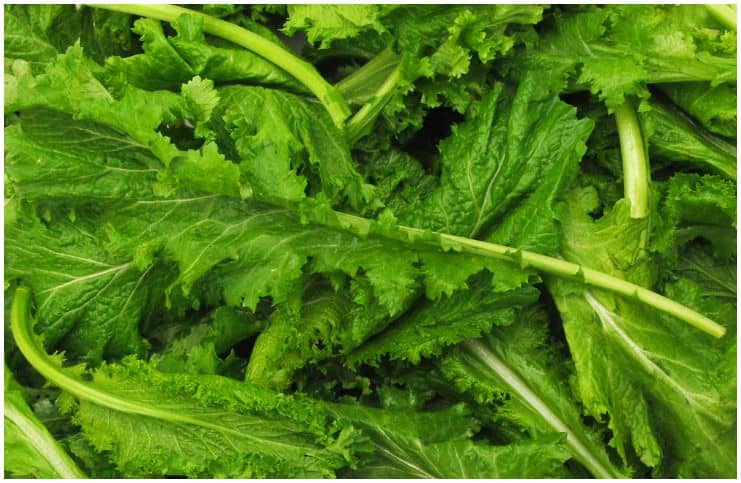Mustard Greens – Side Effects, Health Benefits, Nutrition Facts:
Mustard greens are the leaves of the mustard plant, Brassica juncea, which often appear in Southern cooking, as well as Chinese, Indian, Japanese, and African cuisines.
They are used as a condiment, extensively in cooking, but also in oil production in different parts of South-Asian regions.
The plant originated in the Himalayan region of India and has been grown and consumed for more than 5,000 years. Nowadays, it is used in cuisines all over the world, from China to South America.
Phytoremediation
Phytoremediation is a cost-effective plant-based approach to remediation that takes advantage of the capacity of plants to concentrate elements and compounds from the environment and to metabolize various molecules in their tissues.
Brassica juncea is used in phytoremediation to remove heavy metals, such as lead (Pb), from the soil in hazardous waste sites because it has a higher tolerance for these compounds and stores the heavy metals in its cells.
Moreover, this plant was especially effective at removing cadmium (Cd) from the soil.
Nutrition Facts
They are an excellent source of many vitamins, including vitamin A (in the form of carotenoids), vitamin B1, vitamin B2, vitamin B6, vitamin C, vitamin K and vitamin E, minerals including magnesium, manganese, phosphorus, iron, potassium, copper and calcium.
Also, they are a good source of dietary fiber and protein. Greens are 4.5% carbohydrates, 92% water, 2.6% protein, and 0.5% fat.
Health Benefits
High in dietary fiber
The fiber found in the plant is beneficial for several reasons. It helps control cholesterol levels by interfering with its absorption in the gut.
Enough fiber in the food facilitates smooth bowel movements and thereby offers protection from constipation, hemorrhoids, and colon disease. Increasing the amount of fiber in your daily diet can help lower the amount of toxins in your digestive tract, normalize serum cholesterol levels, and lower high blood pressure.
Eye health protection
They contain 177% of your daily value of vitamin A in just one cup. Vitamin A plays an important role in your sight’s health.
To see the full spectrum of light, your eye needs to produce certain pigments for the photoreceptor cells in your retina to work properly.
A deficiency in vitamin A stops the production of these pigments, leading to night blindness. Your eye also needs vitamin A to care for other parts of your eye, including the cornea, the clear covering on the front of your eye.
Without adequate amounts of vitamin A, your eyes cannot produce enough moisture to keep them properly lubricated.
Cardiovascular protection
Mustard greens support the heart in a variety of ways. For instance, daily consumption of mustard greens is beneficial for lowering the amount of bad cholesterol (LDL) in the human blood, hence, leading to a healthy heart.
Also, the beta-carotene found in the plant decreases the risk of death from cardiovascular disease.
Cancer prevention
They also have remarkably high levels of antioxidants. The mineral manganese and vitamins A, C, and E, all function as antioxidants in the body.
Antioxidants are compounds that interact with and neutralize free radicals, thus preventing them from causing damage. Antioxidants are also known as „free radical scavengers.”
In studies, the presence of increased levels of exogenous antioxidants has been shown to inhibit free radical damage that has been linked with cancer development. So, researchers have concluded that taking dietary antioxidant supplements can help lower the risk of developing or dying from cancer in humans.
Bone health
They contain 524% of your daily value of vitamin K. Many studies suggest that vitamin K plays an essential role in the optimization of bone health and bone metabolism.
Individuals who have higher levels of vitamin K have greater bone density, while low levels of vitamin K have been found in people suffering from osteoporosis. Likewise, some research suggests that low levels of vitamin K are connected with a higher risk of osteoarthritis.
Serving
When choosing mustard greens, know that the smaller, more tender leaves of spring will usually be milder in flavor than the mature leaves of summer and fall. They can be eaten raw in salads and can be juiced with other vegetables and greens.
When storing at home, place the greens in a container or sealed bag and store for up to 3 days. Before using, make sure to wash under cold water for at least 30 seconds.
Side effects of mustard greens
They are among a small number of foods that contain measurable amounts of oxalates, naturally occurring compounds found in animals, plants, and human beings.
Oxalate is also known for its role in calcium-oxalate kidney stones, which is the most frequent form of kidney stone.
Thus, people with known oxalate urinary tract stones are advised to avoid eating vegetables belonging to the Brassica family.
READ THIS NEXT:
Taro Root: Health Benefits and Side Effects
Conyza Canadensis (Canadian Fleabane or Horseweed) Medicinal Properties
References https://www.ncbi.nlm.nih.gov/pmc/articles/PMC3762684/ https://www.ncbi.nlm.nih.gov/pmc/articles/PMC6151555/


